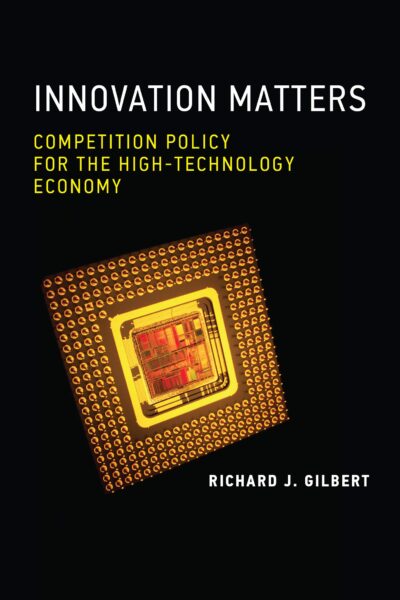What’s wrong with antitrust policy for regulating the tech sector? In his new book, Innovation Matters: Competition Policy for the High-Technology Economy, Richard Gilbert, Distinguished Professor Emeritus of Economics at UC Berkeley, argues that regulators should be considering the effects of mergers and monopolies on innovation, rather than price.
 From 1993 to 1995, Gilbert served as Deputy Assistant Attorney General in the Antitrust Division of the U.S. Department of Justice. He also served as Chair of the Berkeley Economics Department from 2002 to 2005, as President of the Industrial Organization Society from 1994 to 1995, and as the non-lawyer representative to the Council of the Antitrust Section of the American Bar Association from 2011 to 2014.
From 1993 to 1995, Gilbert served as Deputy Assistant Attorney General in the Antitrust Division of the U.S. Department of Justice. He also served as Chair of the Berkeley Economics Department from 2002 to 2005, as President of the Industrial Organization Society from 1994 to 1995, and as the non-lawyer representative to the Council of the Antitrust Section of the American Bar Association from 2011 to 2014.
Julia Sizek, Matrix Content Curator, interviewed Professor Gilbert about the arguments in his new book. (Please note that responses have been edited, and links were added for reference.)
Q: As large technology companies have increasingly come under fire for their monopoly-like powers, many have been asking about how antitrust policy needs to change to address this industry. What motivated you to investigate the changing landscape of antitrust policy?
Traditionally, antitrust policy has been about prices, and antitrust officials have focused on stopping mergers that would increase prices or limiting conduct that would cause prices to rise or prevent them from falling. But we know that innovation — new or improved products or production methods — is more important for the economy and consumer welfare than a reduction in prices. We need to change antitrust policy from price-centric to innovation-centric.
Antitrust authorities appreciate the importance of innovation, but until recently they have not had the tools to analyze how mergers or the conduct of dominant firms might suppress innovation. Many antitrust enforcers and academics endorsed views associated with the writings of Joseph Schumpeter in the 1940s. He wrote that progress proceeds through a process of creative destruction, with new technologies replacing old products and methods, and that large firms were often better suited than small firms to create these new technologies. This Schumpeterian perspective suggested a defense for mergers and monopolization, rather than a basis to challenge them. Indeed, the Merger Guidelines published by the Department of Justice and Federal Trade Commission barely mentioned innovation as a merger concern until they were revised in 2010.
More recent economic research challenges the Schumpeterian perspective and shows how the lack of competition can suppress innovation incentives. Having fewer firms engaged in research and development lowers the probability of discovery. A firm that has monopoly power has little incentive to invest in costly R&D if a successful discovery would merely replace the profits it earns from its existing products. It is no surprise that many major discoveries have been made by firms that do not have existing products that would be threatened by the discovery. Electric vehicles, the smartphone, digital photography, ride-hailing services, digital mapping, photolithography, and mRNA vaccines are some examples of innovations that emerged out of non-dominant firms.
So, the motivation for my book was to collect in one place what we now know about the relationship between competition and innovation. That includes the Schumpeterian perspective, but also more recent scholarship that shows how monopoly is a threat to innovation. My objective was to describe the central principles that support an innovation-centric antitrust policy.
Q: As you note in the book, current antitrust policy in the U.S. asks how consumers would suffer if a merger or acquisition were to be completed, and that this harm to consumers is measured through looking at prices of products. What are the limits of using prices to measure competition (or lack thereof)?
A merger that results in a small reduction in the pace of innovation is likely to cause greater consumer harm than if it causes a small increase in price. That is why we need an innovation-centric antitrust policy when mergers or conduct are likely to affect the pace of innovation.
Sometimes we can account for innovation effects by incorporating quality into product prices. That is, we can measure the consumer benefit from an improvement in the quality of a product by an equivalent reduction in its price, or the consumer cost from a reduction in quality by an increase in price. This is straightforward for some products. If Hershey sells a smaller candy bar at the same price, it is equivalent to an increase in the price of the bar. If a new car gets lower gas mileage, it is equivalent to an increase in the price of the car.
This quality-adjusted price approach has limitations. It is difficult to apply to complex changes in the dimensions of a product. Moreover, in today’s digital economy, many services are provided without a monetary price. It doesn’t make much sense to ask whether the price could be lower, but instead we should ask whether companies are creating new services that benefit consumers or interfering with the ability of other firms to compete with new services.
Digital platforms such as Facebook and Google complicate the analysis because they provide services to consumers (e.g., social networks and search) without a price while generating revenues from advertising. The services that the platforms offer at a zero price and the advertising services that the platform sells at positive prices are interdependent. However, they raise different issues for antitrust analysis. For example, the Federal Trade Commission has filed an antitrust complaint related to Facebook’s acquisitions, including Instagram and WhatsApp. The complaint alleges that Facebook maintained its personal social networking monopoly by systematically tracking potential rivals and acquiring companies that it viewed as serious competitive threats.
A price-centric analysis might be appropriate for the advertising service, but an innovation-centric analysis is more appropriate for the effects of such acquisitions on the quality of Facebook’s social networking services.
Q: Your book offers innovation as a metric to understand antitrust policy. What is innovation, and how does one measure it?
Innovation is a new or improved product or process that differs significantly from previous products or processes. Innovation is more than invention, which is the act of discovering a new product or process, because innovation requires that an invention be put into active use or be made available for use by others.
Innovations can be measured in different ways. This can include direct measures, such as a technical or economic assessment of the value of the innovation. For pharmaceuticals, a new drug application that is approved by the Food and Drug Administration is a measure of innovation, although drugs differ greatly in their therapeutic and economic value. Indirect measures of innovation include the number of patents that cover the innovation. Because patents can differ greatly in significance, economic studies often use citation counts to determine the significance of the patents. Patent counts are generally better indicators of the value of innovations when they are adjusted by citations to measure quality, but there is still a gap between citation-weighted patent counts and the value of innovations. The gap depends on the industry. For example, patent counts tend to be aligned with the values of pharmaceutical and chemical innovations. However, in other industries, patents provide a measure of protection from competition that is not necessarily related to the value of the innovation that is disclosed by the patent. This disconnect is particularly problematic for industries in which many patents cover the same product, such as electronics, software, and communications technologies. In that case, a patented technology can represent a small fraction of the value of a product, yet the patent owner might be able to demand a high royalty because the product cannot be produced with the right to use the patent.
Economic studies of competition and innovation often use research and development (R&D) expenditure to measure innovative effort. R&D, however, is an input to the activity of innovation. It does not measure the output of innovation. R&D expenditures can increase with no effect on the output of innovation, or R&D can become more efficient and decrease with the same or greater output of innovation. Nonetheless, because R&D expenditures are often more accessible than measure of actual innovation, many empirical studies have used R&D expenditure as an indirect measure of innovation.
Q: In the book, you note that the number of complaints about innovation loss increased from the 1990s through the 2010s. What do you think accounted for the new focus on innovation, rather than other kinds of complaints? (In other words, how did innovation emerge as a means of thinking about anti-trust law?)
Courts generally follow economic developments in their evaluations of antitrust law, but usually with a substantial lag. Economic analysis plays a central role in almost every merger case, but economic analysis was almost always absent in merger evaluations that took place before 1980. Economic analysis became important in merger analysis after courts recognized that economics has something to say about whether a merger is likely to result in a “substantial lessening of competition,” which is the standard for review under the antitrust laws.
Economics did not have much to say about the relationship between competition and innovation until the latter part of the 20th century. As I mentioned, the prevailing sentiment was a Schumpeterian view that some monopoly power is conducive to innovation. When innovation appeared in antitrust cases, it was mostly as a defense to otherwise anticompetitive conduct. Indeed, in the monopolization case against Microsoft brought by the Department of Justice and several states, the Federal Court of Appeals quoted Schumpeter in the introduction to its opinion.
Innovation became more of a concern for antitrust enforcement by the Department of Justice and the Federal Trade Commission in the 1990s. This coincided, perhaps incidentally, with the publication by the agencies of the Antitrust Guidelines for the Licensing of Intellectual Property. (I led the effort that resulted in these guidelines when I was Deputy Assistant Attorney General at the Department of Justice.) The Guidelines brought innovation to the forefront.
The DOJ and FTC publish and update guidelines that describe their enforcement intentions for mergers. The first edition was published in 1968. Neither the first edition nor many subsequent editions mentioned innovation as a competitive concern until the guidelines were revised in 2010. (UC Berkeley professors Carl Shapiro and Joe Farrell led the 2010 effort to revise the guidelines.) The 2010 guidelines describe several ways in which mergers might suppress innovation. This discussion paralleled economic developments beginning in the late 20th century that showed why mergers and monopoly power can harm incentives to innovate.
Q: Large technology companies like Alphabet (Google) and Meta (Facebook) are known for acquiring companies in their start-up phases, and this has become widely accepted for small companies in the technology sector. How do you think this model has shifted possibilities for innovation in technology, and how might regulators change their approach to regulating these acquisitions?
Google and Facebook (and Amazon, Apple, and Microsoft) have acquired hundreds of start-ups. Few of these acquisitions were even reviewed by the antitrust agencies, and none was blocked. The reasons for the lack of enforcement are complex. The companies operate in fast-moving technologies, so it is often difficult to know whether a start-up represented a competitive threat to the acquiring firm.
The US and European authorities reviewed, but did not challenge, Facebook’s acquisition of WhatsApp and Instagram. The European Commission noted that WhatsApp and Facebook were but two of many messaging services, and that WhatsApp did not compete with Facebook for online advertising. Both agencies should have paid greater attention to the possibility that WhatsApp could have become a rival social network, much as the multi-purpose messaging service WeChat has done in China (albeit censored by the authorities). Indeed, the $19 billion that Facebook paid for the app, despite little usage at the time in the US, should have been an indicator of its potential as an industry disruptor.
Some acquisitions escape review by the antitrust agencies because they fall below the required reporting thresholds. Many of these acquisitions are “aqui-hires.” They are groups of talented individuals that bear little resemblance to the corporate acquisitions that are the usual targets of antitrust enforcement.
In my opinion, the most significant reason why antitrust enforcers have not been able to restrain the growth of the dominant digital platforms through acquisition is their inability to deal with potential competition. The antitrust agencies are quick to challenge a merger of X and Y when both have large shares of a concentrated market. But what about a dominant company X that acquires a startup Y that has no product, but might develop a product that competes with X? Y is not an actual competitor of X, Y is a potential competitor. Antitrust legal precedents impose a high bar to challenge an acquisition that eliminates a potential competitor.
Congress is currently considering several proposed bills that would strengthen antitrust enforcement, particularly for dominant platforms. While some of these bills are not, in my opinion, a step in the right direction, those that make it easier to challenge acquisitions of potential competitors could, if properly crafted, be a positive change to antitrust enforcement.
Q: How do these approaches to innovation need to change in the context of platform markets, like Google Shopping or Amazon? How do platform economies change how we should think about antitrust issues?
Platforms are challenging for antitrust enforcement. First, for platforms such as Google or Facebook, one side is supplied without a monetary price, although consumers “pay” by supplying valuable data. Second, many platforms have powerful network effects and scale economies from the accumulation of data. Network effects imply that users of the platforms benefit from the participation of other users. Scale economies imply that rivals would have to incur large and irreversible costs to duplicate the values that the platforms obtain from their data. The presence of network effects and scale economies imply large barriers to entry of new platform competitors. For both of these reasons, new competitors can’t gain a toehold in the usual way by providing the same service at a lower price. They have to compete with a differentiated product. Third, there are competitive interactions between the “free” and paid sides of the platforms. Platforms have incentives to maintain service quality on the free side if it is useful to attract paying advertisers, although such incentives are limited. Fourth, innovation concerns are particularly relevant for many platforms because the pace of technology development is rapid and some platform services are provided without charge, which makes a price-centric analysis less useful.
Of course, antitrust is relevant for platforms, and the challenges they present are not entirely new. But enforcement has to be mindful of platforms’ unique characteristics. Designing workable remedies for antitrust abuses is challenging for platforms. Consumers do not benefit from breaking up a platform if network effects imply that only one firm will survive. And behavioral remedies can be difficult to enforce or may have little effect. The Google search remedy imposed by the European Commission is still being criticized as too weak, years after it was first implemented. The European Commission requirements to offer choice screens for default browsers and search engines (i.e., screens that allow users to choose their preferred search engine) has not had a significant effect on utilization. The alternative approach to remedies might involve a regulator that supervises conduct by the platforms or that can impose fines large enough to affect their behavior.
Q: What is the future of antitrust policy in the United States, especially now, when prominent antitrust lawyers Lina Khan and Jonathan Kanter have been confirmed as Chair of the Federal Trade Commission and Assistant Attorney General, respectively?
Interesting question. Lina Khan is a self-professed member of the New Brandeis (NB) movement. The NBs believe that monopoly is a corrosive force for the economy and an obstacle for social justice. They want to break up monopolies without having to demonstrate a pattern of abusive behavior. This will be a tough sell in the courts. Established precedent requires a finding of anticompetitive conduct for a finding of unlawful monopolization under the Sherman Act.
Nonetheless, as Chairman of the FTC, Khan might be able to make some significant changes in antitrust enforcement. The FTC Act empowers the Commission to challenge “unfair” competition. Courts have ruled that the standard for unfair competition is the same standard for violation of the Sherman Act. But the Commission might have wiggle room to bring cases that would be difficult to prove under the Sherman Act. That would be an important development. Furthermore, the FTC has an administrative structure that gives it enforcement leverage that is absent at the Department of Justice. Specifically, the FTC can send cases to an administrative law judge (ALJ) before they go to a traditional court of law. The ALJ process takes time, and some defendants are willing to make concessions to avoid the extra delays.
I don’t expect to see the same movement of the antitrust needle at the DOJ, because the DOJ can’t avoid or delay judgments in the courts. Both agencies can be tougher on merger cases. There is some evidence that is happening and I expect it to continue. (But again, they have to deal with the courts if merging parties contest a challenge.) The DOJ also can have an impact through a process called the business review letter, where it can state an intention not to challenge a practice. For example, Democrats tend to be softer on enforcement of intellectual property rights, and the DOJ can signal this intent through a business review letter.
-
Purchase Professor Gilbert’s book, Innovation Matters: Competition Policy for the High-Technology Economy
-
View other books from UC Berkeley social scientists in the Social Sciences Book Gallery



